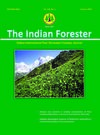Response of Casuarina equisetifolia and Casuarina junghuhniana to Elevated CO2 Levels
DOI:
https://doi.org/10.36808/if/2018/v144i1/121312Keywords:
Plant–CO2 Interaction, Casuarina equisetifolia, Casuarina junghuhniana, Open Top Chambers.Abstract
This paper discusses the response of Casuarina equisetifolia and C. junghuhniana to elevated CO2 concentrations in AOTC. In this study, three months old seedlings of Casuarina were exposed to elevated CO2 levels in open top chambers at 600 ppm and 900 ppm for a period of three months. Simultaneously, seedlings were also kept as control in open top chambers without CO2 enrichment and also in the ambient environment. Observations were made on growth parameters, dry matter accumulation, nutrient uptake and photosynthetic enzymes (RuBisCO and CA) activity. Both Casuarina equisetifolia and C. junghuhniana registered greater mean increment in height growth (73.29 and 77.25 cm in three months respectively) under high CO2 concentrations of 900 ppm when compared to control conditions (being 68.38 and 69.38 cm respectively for Casuarina equisetifolia and C. junghuhniana). The study concludes that there exists huge intra-specific variation both in Casuarina equisetifolia and C. junghuhniana, which could be exploited for future breeding programme in developing climate ready genotypes having greater potential to sequester more CO2.References
Bassirirad H., Prior S.A., Norby R.J. and Rogers H.H. (1999). A field method of determing NH4+ and NO3- uptake kinetics in intact roots: effects 4 3 of CO2 enrichment on trees and crop species. Plant and Soil, 217: 195–204.
Ceulemans R., Jiang X.N and Shao B.Y. (1995). Growth and physiology of one-year old poplar (Populus) under elevated atmospheric CO2 levels. Annals of Botany, 75(6): 609-617.
ESRL (2017). Earth System Research Laboratory (ESRL). 2017. Trends in atmospheric Carbon Dioxide. https://www.esrl.noaa.gov/gmd/ccgg/trends/gr.html.
Fangmeier A., Grüters U., Högy P. Vermehren B. and Jäger H.J. (1997). Effects of elevated CO2 nitrogen supply and tropospheric ozone on spring wheat — I. Nutrients (N, P, K, S, Ca, Mg, Fe, Mn, Zn). Environmental Pollution, 96: 43-59.
Ghashghaie J. and Cornic G. (1994). Effect of temperature on partitioning of photosynthetic electron flow between CO2 assimilation and O2reduction and the CO2 /O2 specificity of Rubisco. J. Plant Physiology, 143: 643-650.
Humphries E.C. (1956). Mineral components and ash analysis. In: Modern methods of plant analysis. Vol. 1. Paech, K. and Tracey, M.V. (eds.) Springer-Verlag, Berlin, 468-502 pp.
IPCC(2014). Climate Change 2014: Synthesis Report. Contribution of Working Groups I, II and III to the fifth assessment report of the Intergovernmental panel on climate change [Core Writing Team, R.K. Pachauri and L.A. Meyer (eds.)]. IPCC, Geneva, Switzerland, 151 pp.
Isebrands J.G., McDonald E.P., Kruger E., Hendrey G.R., Percy K.E., Pregitzer K.S., Sober J. and Karnosky D.F. (2001). Growth responses of Populus tremuloides clones to interacting elevated carbon dioxide and tropospheric ozone. Environmental Pollution, 115(3):359-371.
Jackson M.L. (1962). Soil chemical analysis. Prentice- Hall, Englowood Cliffs, N. J.
Johanna R., Lindsberg M.M, Holopainen T., Oksanen E., Lappi J., Peltonen P., Vapaavuori E. (2003). Silver birch and climate change: variable growth and carbon allocation responses to elevated concentrations of carbon dioxide and ozone. Tree Physiology, 24: 1227-37.
Korner C., Asshoff R., Bignucolo O., Hattenschwiler S., Keel S.G., Pelaez-Riedl S., Pepin S., Siegwolf R.T.W. and Zotz G. (2005). Carbon flux and growth in mature deciduous forest trees exposed to elevated CO . Science, 309: 1360-1362. 2
Murray M.B., Smith R.I., Leith I.D., Fowler D., Lee H.S.J., Friend A.D. and Jarvis P.G. (1994). Effects of elevated CO2, nutrition and climatic warming on bud phenology in Sitka spruce (Picea sitchensis) and their impact on the risk of frost damage. Tree Physiology, 14:691--706.
Nicodemus A., Varghese M. and Nagarajan B. (2001): Genetic improvement of Casuarina equisetifolia through selection and breeding. In: Casuarina in India: Improvement and Utilization (Gurumurthi, K., Nicodemus, A. and Siddappa (eds.). Institute of Forest Genetics and Tree Breeding, Coimbatore, India. 3–13 pp.
NOAA (2017). Annual mean growth rate of CO2 at Mauna Loa, Earth System Research Laboratory, National Oceanic and Atmospheric Administration, U.S. Department of Commerce.
OECD (2012). The OECD Environmental Outlook to 2050, Organization for Economic Co-operation and Development.
Simon P.R., Virginia J.S., Mark C.J. and Archie R.P. (1988). Purification and Assay of Rubisco Activase from Leaves. Plant Physiol., 88: 1008-1014.
Van Vuuren M., Robinson D.M.L., Fitters A.H., Chasalow S.D., Lisa W. and Raven J.A. (1996). Effects of elevated atmospheric CO2 and soil water availability on root biomass, root length, and N, P and K uptake by wheat. New Phytology, 135: 455-465
Warren C.R. and Adams M.A. (2004). Evergreen trees do not maximize instantaneous photosynthesis. Trends in Plant Science, 9: 270-274.
Wilbur K.M., and Anderson N.G. (1948). Electronic and colorimetric determination of carbonic anhydrase. J. Biological Chemistry, 176: 147- 154.
Downloads
Downloads
Published
How to Cite
Issue
Section
License
Unless otherwise stated, copyright or similar rights in all materials presented on the site, including graphical images, are owned by Indian Forester.





